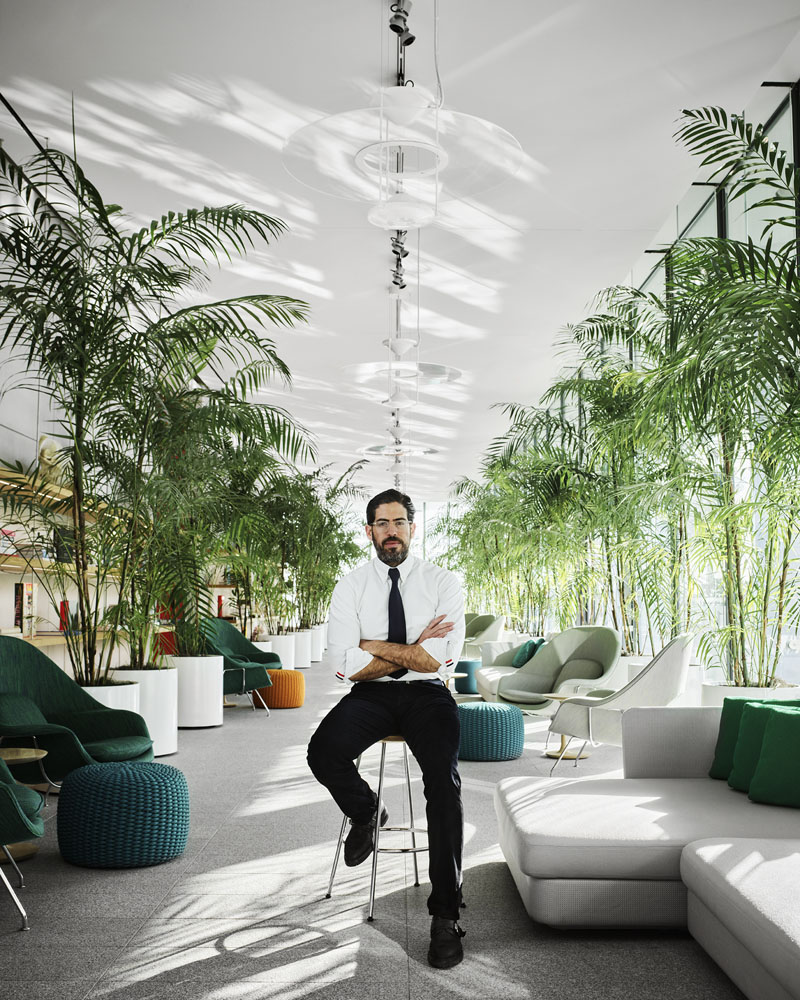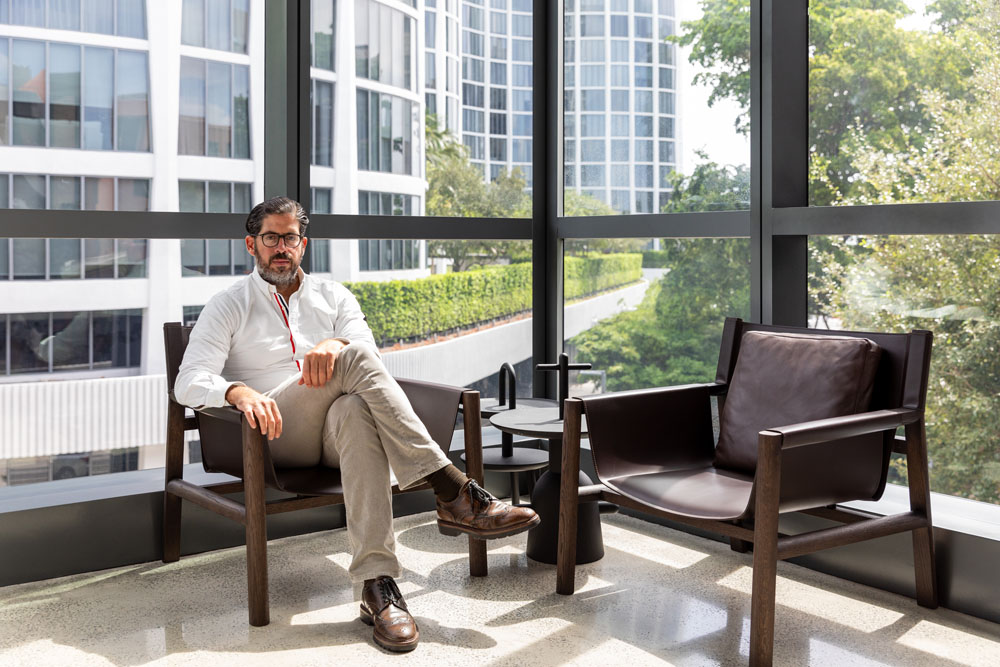David Martin, CEO y cofundador de Terra, es uno de los desarrolladores inmobiliarios más visionarios del sur de la Florida. Sus proyectos buscan transformar el sur de la Florida, guiados por una visión que apuesta por un futuro más brillante.
Desde que fundó Terra en Miami en 2001, Martin ha liderado el desarrollo de apartamentos multifamiliares, condominios de lujo, espacios comerciales, hoteles y proyectos de uso mixto en las ubicaciones más codiciadas del sur de Florida.
Reconocido por su dedicación a la excelencia en el diseño y la sostenibilidad, Martin ha colaborado con arquitectos de renombre mundial como Rem Koolhaas, Renzo Piano y Bjarke Ingels. Este enfoque colaborativo da vida a proyectos que impactan positivamente a las comunidades y su entorno.
Más allá de sus logros profesionales, Martin está profundamente comprometido con iniciativas cívicas y culturales. Ha contribuido a proyectos como The Underline, formó parte del Biscayne Bay Task Force en el condado de Miami-Dade y ha apoyado instituciones como Miami Children’s Health Foundation, Vizcaya Museums and Gardens, The Freedom Tower, The Bass Museum y la Fundación YoungArts.
 Entrevista con David Martin:
Entrevista con David Martin:
¿Nos puede describir la magnitud del proyecto recientemente aprobado en Watson Island y lo que significará para nuestra comunidad?
Watson Island, estratégicamente ubicada en el corazón de Miami y el condado, ha sido objeto de propuestas durante años, pero no se logró un avance significativo durante décadas. Nuestro enfoque fue encontrar un modelo de negocio que beneficiara a la comunidad. Lo que se logró con Jungle Island fue notable en su momento, pero sentimos que era hora de una nueva visión.
El proyecto aprobado incluye un parque público de 13 acres, que ofrecerá un espacio mucho más accesible e inclusivo para la comunidad mientras minimiza el impacto ambiental. Durante años, los residentes de Venetian Causeway han expresado preocupaciones sobre el ruido y las actividades provenientes del Joia Beach Club y otros eventos en el sitio de 18 acres, afectando su calidad de vida. Trabajamos en colaboración con partes interesadas, incluyendo clubes náuticos, residentes y asociaciones vecinales, para reimaginar este espacio.
El objetivo es “verdear” la isla, maximizando el espacio de parque público. De los 13 acres, solo cinco (30%) estarán destinados a un desarrollo residencial de bajo impacto y alto valor fiscal, mientras que el 70% restante se dedicará a espacios verdes con un enfoque ambiental. Esta decisión recibió casi el 60% de apoyo, confirmando que vamos en la dirección correcta.
________________________________________
Tiene proyectos importantes en el horizonte. ¿Cuándo comenzará la construcción en el sitio de Deauville Beach Resort y cuáles son los planes?
Estamos trabajando con la Ciudad de Miami Beach en cambios legislativos que permitan replicar el histórico edificio. Hemos colaborado con la comunidad de preservación histórica y los residentes de North Beach. Nuestro objetivo es desarrollar algo icónico y especial, reimaginando un vecindario vibrante.
El plan incluye una componente residencial como parte de una revitalización del área. Nos hemos unido con arquitectos increíble. El proyecto abarcará 10 cuadras, desde la calle 62 hasta Town Center y la calle 72, con aceras sombreadas, infraestructura mejorada y espacios verdes.
________________________________________
¿Existen actualizaciones sobre el proyecto Silver Sands Beach Resort en Key Biscayne? ¿Cuál es su visión de este proyecto?
Sí, logramos aprobación a pesar de una moratoria de densidad. Agregamos 56 grandes unidades residenciales y obtuvimos la aprobación del plan del sitio tras extensas reuniones con la comunidad local y nuestros vecinos de Tidemark Key Colony y Oceana para asegura impacto mínimo.
El proyecto tendrá un diseño moderno tropical, y esperamos iniciar la construcción en 2026.
________________________________________
Sus proyectos han transformado significativamente el horizonte de Miami. ¿Cómo ve la evolución de la ciudad en la próxima década?
Desde 2001, nuestra misión ha sido crear entornos que mejoren la vida de las personas. Ahora, pensamos más en ecosistemas de vecindarios completos. Empezamos con edificios y ahora pensamos más en los vecindarios y sus ecosistemas y somos muy consciente del diseño.
Por ejemplo, financiamos Regatta Park, que se ha convertido en un gran activo para la comunidad. Inspirados en Jane Jacobs, fomentamos cambios liderados por la comunidad en lugar de imponer proyectos.
Operamos en más de 20 municipios, abordando necesidades económicas, culturales y de planificación urbana, con la visión de que mejores vecindarios conducen a mejores desarrollos.
________________________________________
La sostenibilidad se ha vuelto clave en sus desarrollos. ¿Qué prácticas o tecnologías están integrando?
Abordamos la sostenibilidad desde dos ángulos: reducir la huella de carbono y mejorar la resiliencia económica. Nuestros edificios cuentan con certificaciones LEED. Fuimos los primeros en lograr la certificación Gold para un edificio residencial en Miami. Incorporamos soluciones como reciclaje de agua, sombreado, enfriamiento geotérmico y manejo de aguas pluviales.
El urbanismo también juega un papel clave. Al desarrollar en núcleos urbanos, reducimos el uso del automóvil y los tiempos de viaje, beneficiando al medio ambiente. En cuanto a la resiliencia, nos enfocamos profundamente en la gestión de aguas pluviales. Por ejemplo, Canopy Park en Miami Beach cuenta con 12 pozos que manejan el agua de lluvia de toda la cuenca de South Beach, mejorando la calidad del agua y reduciendo la presión sobre los sistemas de bombeo. Además, exploramos formas de incentivar comportamientos sostenibles entre propietarios y empresas.
________________________________________
¿Siempre fue su pasión ser desarrollador? ¿Cómo empezó?
No fue mi plan inicial. Estudié leyes y obtuve un MBA. En la universidad, abrí un café (sin permiso) y eso me enseñó mucho sobre regulaciones urbanas, despertando mi interés por crear cosas. El desarrollo es desafiante pero gratificante, y equilibrarlo con la vida familiar es una prioridad constante.
________________________________________
¿Qué legado espera dejar en Miami y en la industria inmobiliaria?
Quiero demostrar que el desarrollo puede beneficiar tanto a la comunidad como al negocio. Cuando los proyectos ayudan a las personas, el apoyo es mucho mayor. Busco probar que el capitalismo puede resolver desafíos sociales mientras mejora vecindarios y vidas.
________________________________________
¿Cuáles son algunas iniciativas comunitarias o filantrópicas que le apasionan?
La educación es mi mayor pasión. Soy parte de Teach for America, ya que creo que los maestros son los héroes no reconocidos de nuestra sociedad. También apoyo causas de salud como múltiple sclerosis (MS), preservación histórica y programas como, Overtime Youth Center y Big Brothers Big Sisters.
Una iniciativa especial fue un evento estilo Shark Tank para niños en cuidado de acogida, donde presentaron ideas de negocio a un panel. Estos esfuerzos reflejan valores que aprendí de mis padres: compasión, generosidad y el compromiso de devolver a la comunidad.
Beyond the Skyline: Purpose-Driven Real Estate Developer
David Martin, CEO and co-founder of Terra, is one of South Florida’s most visionary real estate developers. His projects are not just about building properties, but about reshaping South Florida’s landscape for the future.
Since founding the Miami-based firm in 2001, Martin has spearheaded the development of multifamily apartments, luxury condominiums, retail spaces, hotels, and mixed-use projects in South Florida’s most sought-after locations.
Renowned for his dedication to design excellence and sustainability, Martin has collaborated with world-class architects such as Rem Koolhaas, Renzo Piano, and Bjarke Ingels. This collaborative approach creates impactful projects that enhance communities and their surroundings.
Beyond his professional achievements, Martin is deeply committed to civic and cultural initiatives. He has contributed to projects like The Underline, served on Miami-Dade County’s Biscayne Bay Task Force, and supported institutions such as the Miami Children’s Health Foundation, Vizcaya Museums and Gardens, The Freedom Tower, The Bass Museum, and the YoungArts Foundation.
Q & A with David Martin:
Could you briefly describe the magnitude of the recently approved Watson Island project and what it will mean to our community?
Miami’s Watson Island is strategically located in the city’s heart and the county. The City of Miami initiated various procurements and proposals for many years, but decades passed without significant progress. Our approach was to find a business case that could benefit the community. What was done with Jungle Island was remarkable for its time, but we felt it was time for a new vision. The recently approved Watson Island project, a 13-acre park that will be open to the public, will provide a much more accessible and inclusive space for the community while minimizing impact.
We proposed a 13-acre park that will be open to the public, providing a much more accessible and inclusive space for the community while minimizing impact. For years, residents of Venetian Causeway have voiced concerns about the noise and activities from Joia Beach Club and other events on the 18-acre site, which have negatively affected their quality of life. We collaborated with various stakeholders, including the Yacht Club, the Outdoor Club, the Venetian Causeway residents, and other neighborhood associations. We realized that it had contributed little to the community, and we saw an opportunity to make a change.
We aim to “greenify” the island and create as much open park space as possible. Our proposed development on 13 acres will have the least traffic impact compared to previous proposals. Our residential project will generate 50% less traffic while providing four times the tax revenue for the city. We proposed a low-impact, high-taxable value residential development on just five acres (30% of the site). The remaining 70% will be dedicated to environmentally focused green spaces for the community. It’s the right decision; our support—close to 60% of the votes—confirms this.
You have some significant projects on the horizon. When will you break ground on the Deauville Beach Resort site, and what are the plans?
We’re currently working with the City of Miami Beach on a few legislative changes to allow us to replicate the historic building. We’ve been collaborating closely with the historic preservation community, including the Miami Beach Preservation League and North Beach residents. Our goal is to develop something iconic and special—a reimagined village.
The plan includes a residential component as part of a broader neighborhood revitalization. We’ve partnered with incredible architects, though we have yet to announce them. We aim to create a walkable, friendlier district with shaded sidewalks, improved infrastructure, and green spaces. The project spans from 62nd Street to Town Center and 72nd Street, covering ten blocks that will be completely reimagined to reinvigorate the neighborhood.
Are there any updates on Key Biscayne’s Silver Sands Beach Resort purchase? How do you envision this project?
Yes, we received approval despite a density moratorium. We were able to add 56 large residential units to the site and obtained site plan approval a few months ago. This process involved extensive community outreach and meeting with immediate neighbors like Tidemark Key Colony and Oceana, and many residents to ensure minimal impact.
The project will feature a tropical modern design, which we’re very excited about. Pre-development is underway, and we’re preparing to launch the residential side of the project, with groundbreaking expected in 2026.
Your projects have significantly influenced Miami’s skyline. How do you envision the city evolving over the next decade?
I started the company in 2001, and our mission has always been to create environments that enhance people’s lives. Over time, my approach has evolved. While initially focused on individual buildings, I now think more about entire neighborhoods and their ecosystems, and we are very design driven.
We also funded Regatta Park, which has become a fantastic asset for the community. Our developments aim to serve not just residents but also as catalysts for positive neighborhood transformation. We embrace a Jane Jacobs-inspired approach, fostering community-driven change rather than imposing projects.
Our firm operates in over twenty municipalities, each with unique needs. We strive to understand these areas from economic, cultural, and urban planning perspectives and positively influence them. Ultimately, better neighborhoods lead to better developments.
Sustainability has become a key focus in your development. What sustainable practices or technologies are you integrating into your projects?
We approach sustainability from two angles: reducing carbon footprints and enhancing economic resiliency.
Our buildings are LEED-certified, and we were the first to achieve Gold certification for a residential building in Miami. To reduce energy consumption, we incorporate shading, water recycling, reuse water, geothermal cooling, and other nature-based solutions.
Urbanism also plays a key role. Developing in urban cores reduces car usage and travel times, which positively impacts the environment. On the resiliency side, we focus heavily on stormwater management. For example, Canopy Park in Miami Beach has 12 wells that manage stormwater for the entire South Beach Basin, improving water quality and reducing stress on pump systems. We also explore ways to incentivize sustainable behaviors among property owners and businesses.
Was being a developer always your passion? How did you get started?
No, it wasn’t initially my plan. I have a law degree and an MBA. While in college, I opened a coffee shop—without a permit, as it turned out! That experience taught me much about navigating city regulations and sparked my interest in creating things. Development is advantageous but also very challenging. Balancing this passion with family life is a constant priority for me.
What legacy do you hope to leave in Miami and the real estate industry?
My legacy will reflect my ability to develop business cases that benefit society. Too often, business and community goals are seen as separate. However, when development helps the community, people are more willing to support it. I aim to prove that capitalism can solve societal challenges while improving neighborhoods and lives.
What are some of the philanthropic or community initiatives that you’re passionate about?
Education has always been one of my greatest passions. I serve on the board of Teach for America because education is the foundation of strong communities. Teachers are the unsung heroes—our society’s true rock stars.
I am also deeply involved in other community-focused initiatives. I’m passionate about historic preservation and health-related causes, supporting efforts to combat multiple sclerosis (MS). My involvement with organizations like the Overtime Youth Center further reflects my commitment to making a difference in underserved neighborhoods, and I participate in programs like Big Brothers Big Sisters.
One initiative that stands out was a Shark Tank-style event we organized for a foster care program in Homestead. It was an inspiring experience, where foster kids pitched their business ideas to a panel of judges.
These efforts are grounded in the values I learned from my parents—compassion, generosity, and a commitment to giving back. It’s about striving to make a meaningful, positive impact while remaining kind, grounded, and connected to the community.



 Contact Us
Contact Us